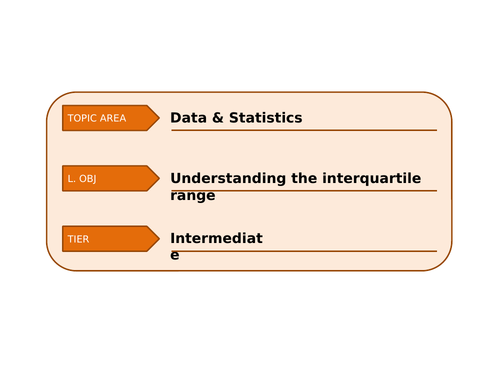

Understanding the interquartile range.
Complete lesson aimed primarily at students working at intermediate/higher level in KS4 but could also be used in late KS3 with higher groups.
The resource helps students understand how the interquartile range differs from the range and why looking at the IQR as a measure of spread can prove to be more useful than the range in certain circumstances.
Although this lesson leads perfectly into box plots, the aim here is to establish a secure understanding of what the IQR is and how it is found from a set of numeric data.
Teaching this topic over a number of years I have found that despite students showing confidence in calculating the IQR, they often struggle making valid comments as to what this measure of spread is telling them about the data. This lesson also aims to address this common issue.
The resource includes:
-Key vocabulary
-Fully animated visual representation of what the IQR is
-Warm-up activity getting students to find the median and range
-Fully animated walkthrough showing students how to find the LQ, UQ & IQR
-Class discussion points to develop thinking on range versus IQR
-‘Always True’ activity to deepen understanding on commenting on IQR
-Independent ‘You Do’ practise questions on finding and commenting on IQR
-Answers to the practise questions
-Fully animated walkthrough showing students how to compare using IQR
-Independent ‘You Do’ practise questions on comparing using the IQR
-Answers to the practise questions
-GCSE exam question
If you purchase and like the resource, please rate it and let me know as this is one of a series of lessons on data which I will be happy to upload if this one proves successful.
Thank you. I hope you enjoy!
PazzaMaths
Something went wrong, please try again later.
IQR is part of the specification for GCSE Geography and I must admit to having been stumped by how to teach it. I have asked the Mathematicians but as always their autism and haughtiness prevents any meaningful help. This resource nailed it - I will of course be amending it by providing more Geographical-based examples after the mid point of the lesson (dare I say, in the upper quartile of the lesson?) but it has really helped and it animated in much the same way as I do my own lessons. Spot on.
Report this resourceto let us know if it violates our terms and conditions.
Our customer service team will review your report and will be in touch.